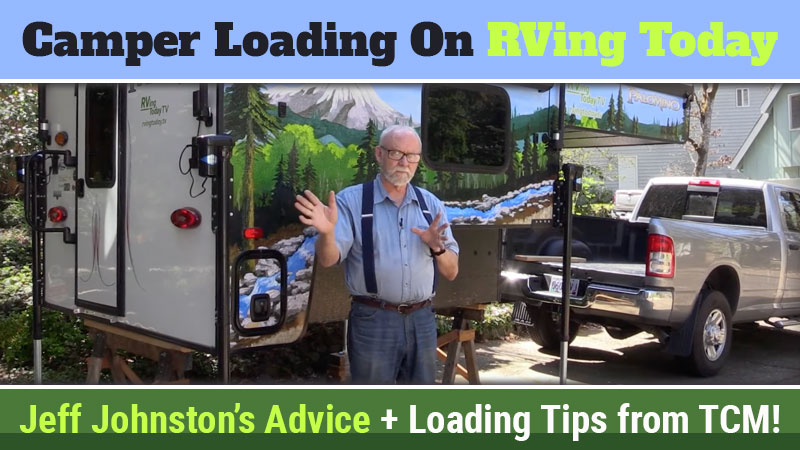Jeff Johnston of RVing Today airs his first home truck camping loading experience on television for the world to see. As a bonus, we also share our camper loading methodology.

In 2021, RV journalist, Jeff Johnston, purchased a Palomino SS-1240 pop-up truck camper for his personal and professional use. Since then he’s shared numerous personal truck camping adventures with us and featured his camper on the television show he co-hosts, RVing Today.
For his latest truck camping segment, Jeff tackled the topic of loading a truck camper. This isn’t Jeff’s first rodeo with a truck camper, but it was his first time loading his Palomino at home.
Above: Jeff Johnston on loading his Palomino SS-1240 camper
As you will see, Jeff had a fairly straightforward (in reverse) time loading his camper. Having known Jeff for the better part of 16 years now, I can attest that he’s a thorough and meticulous individual, and left little room for chance. He’s also been around trucks, campers, and every form of RV imaginable for decades. Put another way, please do not expect your first-time loading experience to go as smoothly. Ours certainly did not.
How We Load Our Truck Camper
I always give the same advice to truck camping newbies who ask about loading and unloading. First and foremost, expect it to be an experience. This is similar advice you might give to a child learning how to ride a bike. It’s not something you do without a bit of practice, and trial and error. If you have a small meltdown with your partner, realize that it is part of the process; choice words and hand gestures included.
Now that you’re mentally prepared for the challenge, relax. Loading a truck camper is not that hard, but it takes a bit of strategy and practice. We have had dozens of manufacturers, dealers, and truck camper owners show us how they load a truck camper. The only trick is to realize there is no trick. It’s a step-by-step process.
Here’s how we load a camper. Some of these steps are a big “duh” but that’s what they are.
Tip: Make sure you have at least a half-hour to load a camper. We now load campers in under 10 minutes, but we took considerably longer in the early days. This is normal.
Tip: Make sure the weather is suitable. Low to no wind and daylight are highly recommended. You can do midnight loading in a hurricane once you’ve mastered the skills, but not your first time out.
1. Raise the camper to be high enough to clear the bed of the truck. If you’re not sure, use a measuring tape. Trust me when I say it’s no fun bottoming out on the truck bed mid-load.
2. Line up the truck with the camper. This might be the most important and the hardest part. Use your side mirrors and – preferably – an outside spotter during this process. This can take a few tries to get right.
Tip: For our rig, before backing up we make sure that our license plate is off our truck. Some people tape a note on their jack remote (if you have one) so they remember to move their license plate. Some have rigs where the license plate can be seen when the camper is on the truck, so it does not need to be moved.
Tip: Once the truck and camper are lined up, make sure the truck and camper are also horizontally lined up. Stand at the front of the truck and look at the camper overcab above it. If the camper is not level to the truck, use the jacks and adjust the camper. In extreme cases, you might then need to go back and check the truck and camper are still lined up (number 4).
Tip: Keep the cabover nose slightly higher than the back of your camper. Also, make sure as you are backing up that the truck is going in between the jacks.
3. With one of you standing on the passenger’s side of the truck (right where the truck cab and bed meet), back the truck under the camper. The person outside (normally yours truly) watches inside the truck bed and gives subtle steering correction instructions to the driver (Angela).
4. When the truck is approximately four-fifths the way in, I connect the front umbilical. If your umbilical is on the rear, you can skip this step.
5. As the front of the camper approaches the truck cab, I tell Angela, “two feet…. one foot… six inches… two inches…”. All the while I’m watching to make sure the camper is square to the truck and we’re centered. If you lightly bump the camper, that’s okay. When you put the truck in park, it will probably space out an inch anyway.
6. When the camper is all the way into the truck bed, Angela puts the truck into park. Sometimes you need to account for a little roll the truck will do once you take your foot off the brake.
Tip: If we’re on a slope, we sometimes use the emergency brake to prevent the truck from moving.
7. Lower the camper down, put on the turnbuckles, connect the rear umbilical if you have one, check the turn signals and brake lights, and go truck camping.
Note that every truck and camper combination has loading quirks that you need to learn. For example, our Ram’s truck bed curves towards the back, and our camper has a rear subwing that needs to be about an inch from the rearmost truck.
Someday I’ll write a deeper dive on this topic complete with funny (and not so funny) anecdotes of loading and unloading over the years. Lord knows I have a few. In the meantime, thank you to Jeff Johnston for literally airing this important topic for the world to see. Nobody needs to fear loading and unloading a camper, but it does take practice.
























